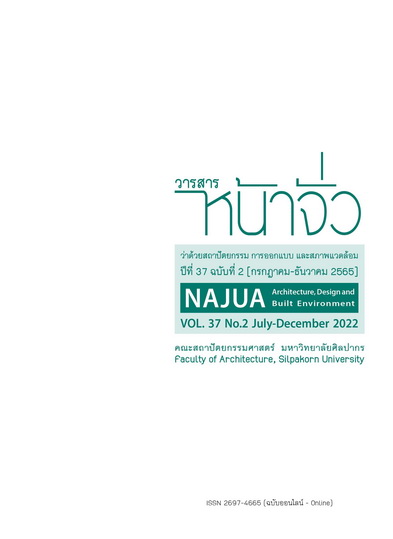Development of Shophouse’s Architectural Style in Huai Yot Tin Mine Town
Keywords:
Shophouse, Row House, Tin Mine Town, Southern of ThailandAbstract
“Huai Yot Town” is a town located on the west side of the southern Thai peninsula next to the Bandat mountain range that extends in the north-south direction. The important ore is tin, making Huai Yot a town of opportunity. Causing people to flock to settle in Huai Yot town and begin urban planning and construction for residential, commercial, and business purposes. In a manner known as a shophouse, which develops the city on the Malay Peninsula. Especially the George Town on Penang Island has affected the south-western Thai peninsula, which is not far away from each other. and people have had kinship ties and business relationships for a long time. As can be seen, the architectural design ideas that are projected through the prevalent shophouses in Georgetown, Penang Island, have been transferred to other towns such as Phuket, Takua Pa, Kantang, and Huay Yot.
The study found that the typology of a shophouse in Huai Yot town can classify the architectural styles of shophouses as follows: 1) Local Style 2) Southern Chinese Eclectic Style 3) Southern Thai and Malay Eclectic Style 4) Pre-Modern Style 5) Early Modern Style, which has an architectural development that is related to the shophouse styles found in George Town at Penang Island, Phuket Town, and Kantang Town.
At the beginning of the settlement and building of Huai Yot town The development of shophouse architecture is closely related to the popular style in Georgetown, Penang Island, as they are closely related. However, in the early 20th century, the central government in Bangkok built a railway line and Petchkasem Road down to the south-west side for the development of Kantang town to act as a trading port. has brought the proximity of Huai Yot town to the central part of Bangkok closer together. This can be seen in the architectural style of the shophouses built since the beginning of the 20th century.
References
Akram Zwain, Azizi Bahauddin. (2017). “The Traditional Courtyard Architectural Components of Eclectic Style Shophouses, George Town, Penang” in 7th International Transaction Journal of Engineering, Management, & Applied Sciences & Technologies.
Document Processing and Archives Committee. (1999). watthanatham phatthana kan thang prawattisat ekkalak læ phumpanya čhangwat Trang. (in Thai) [Culture, Historical Development, Identities and Local Wisdom in Trang Province]. BKK: Document Processing and Archives Committee.
Francis Loj Kok Wah. (1988). Beyond the Tin Mines: Coolies, Squatters and New Villagers in the Kinta Valley, Malaysia, c.1880-1980. Singapore: Oxford University Press. p.9.
kantham mưang dibuk nai prathet Thai. (in Thai) [Tin mining in Thailand]. Retrieved from http: http://library.dmr.go.th/elib/cgi-in/opacexe.exe?op=mmvw&db=Main&sid=&skin=u&usid=&mmid=2048&bid=32800
Kirdsiri K., Wongpradit P., Buranaut I., and Janyam K., (2021). čhot tha ko pinang čhak mưangtha prawattisat su mưang moradok lok. (in Thai) [George Town, Penang Island: from historic port town to world heritage town]. BKK: Faculty of Architecture, Silpakorn University.
Laokaewnu T. (2007). næothang kananurak læ fưnfu mưang huai yot čhangwat Trang. (in Thai). [Guideline for conservation and rehabitation of Huay Yod Town, Trang]. BKK: Chulalongkorn University.
Lim Chong Yah, (1968). Economic Development of Modern Malaya. Kuala Lumpur: Oxford University Press: International Tin Council. 1968.
Loh, Francis Kok-Wah. Beyond the Tin Mines: Coolies, Squatters and New Villagers in the Kinta Valley, Malaysia, c.1880-1980. Melbourne: Oxford University Press Australia, 1989
N.A.M. Omar, S.F.Syed-Fadzil. (2011). “Assessment of Passive Thermal Performance for a Penang Heritage Shop house” in The 2nd International Building Control Conference 2011.
Oliver, P. (1998). Encyclopedia of Vernacular Architecture Volume 1. Cambridge: Cambridge University.
Pinang Gazette and Straits Chronicle. Refer in Wong Yee Tuan. (2015). Penang Chinese Commerce in the 19th Century: The Rise and fall of the Big Five. Singapore: ISEAS National University of Singapore. p.4.
Praya Trang Ka Bhumi Pala. “phlengyao saka rop ra borommathat nirat pai Trang”. (in Thai) in Wannakam phraya Trang. (In Thai) Retrieved from http: https://vajirayana.org
Promket T. (2017). “Penang-Phuket-Trang Trading Network, Mining and Overseas Chinese (1910s to 1980s)”. in History Journal – SWU. 2560 (August 2017-July 2018), pp. 67-87.
Steve Blunden, Tony Wallace. “Tin in canned food: a review and understanding of occurrence and effect” in Food and Chemical Toxicology. Volume 41, Issue 12, December 2003, Pages 1651-1662.
Swettenham, F. A. 1893. “VI Mining”. About Perak. Singapore: Straits Times Press. p.31-36.
Tan Yeow Wooi. (2015). Penang Shophouses: A handbook of Features and Materials. Penang: Tan Yeow Culture and Heritage Research Studio.
Wong Yee Tuan. (2015). Penang Chinese Commerce in the 19th Century: The Rise and Fall of the Big Five. Singapore: ISEAS National University of Singapore. p.4.
Wongpradit P. (2014). kansưksa phatthanakan rupbæp khong tưkthæo čhangwat Trang. (in Thai) [The study of shophouse development in Trang Province]. (Master Degree Thesis), BKK: Silpakorn Univerasity.
Wongpradit P., Kirdsiri K. and Chapman W., (2022). “Shophouse façade designs in the port towns of the Andaman Sea and Malay Peninsula” in HASSS. Volume 22, Number 2 (May-August), 2022. p. 452-465.
Wongpradit P., Kirdsiri K., Panin O., (2015). “boribot wætlom thi song phon toaka roko tua læ kanphatthana khong tưkthæo nai phum that yan prawat tisat thap yong čhangwat Trang”. (in Thai) [Contexts Affecting Architectural Form of Shophouse and Its Development, Historic Urban Landscapes of Tub Tiang, Trang Province] in Najua: Architecture, Design and Built Environment. vol. 29 (2015): January - December 2015. p. 205-222.
Wongpradit P., Kirdsiri K., Panin O., (2021) “bot sang khro waduai phatthanakan rup bæp so tha pot yok ra rom hongthæo mưangtha chaifang thale an da man læ khapsamut malayu fak tawantok” (in Thai). [The Synthesis of Row house’s Development in the Port Towns on the Andaman Sea Coast and the Western Part of Malay Peninsula] in Najua: History of Architecture and Thai Architecture. Vol. 18 No. 2 (2021): July - December 2021. p. 75-103.
Downloads
Published
How to Cite
Issue
Section
License

This work is licensed under a Creative Commons Attribution-NonCommercial-NoDerivatives 4.0 International License.





